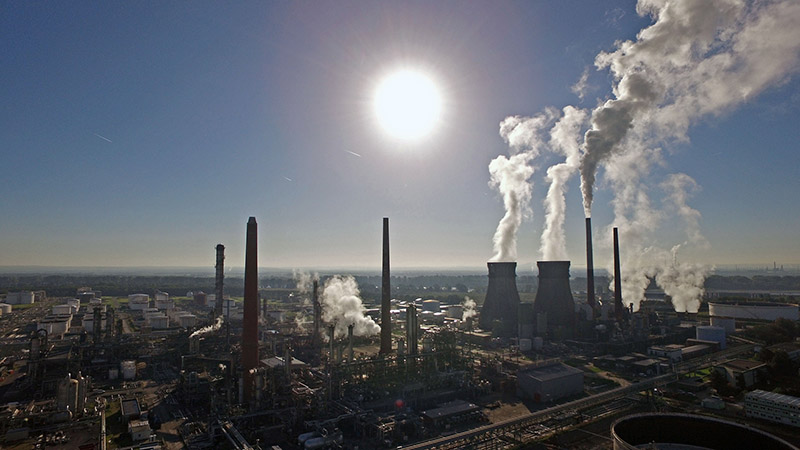Government receipts from carbon pricing schemes leapt 60% to US $26 billion through 2015, a World Bank study revealed on Wednesday.
The news comes amid widespread gloom over the impact of global carbon markets and pricing mechanisms, which are now operating in 40 countries.
While national coffers are swelling, there’s little sign it’s having the opposite impact on greenhouse gas emissions.
According to a separate study from consultants PwC, to meet the targets laid out in last December’s UN climate deal a tonne of CO2 should be rated at US$45, far higher than prices in major markets.
Europe’s emissions trading scheme (ETS) costs a tonne at $6, as do pilot markets in Beijing, Shenzhen and RGGI, a North American initiative comprised of nine US states.
Low prices are an “ongoing concern as they are not sending a signal to business,” said Jonathan Grant, a director in PwC’s climate and sustainability unit.
Stig Schjølset, head of EU carbon analysis at Thomson Reuters, told Climate Home there had been little noticeable change in carbon trading or prices since the 2015 Paris Agreement.
“If you look at what’s happening on ground in carbon markets, it’s like Paris did not happen,” he said.
Carbon markets in numbers
Highest price: $137/t (Sweden carbon tax)
Lowest price: $1/t (Poland and Mexico’s carbon tax)
40 countries, 20 cities, states and regions are involved
1000 companies are using or plan to use an internal price ranging from $1-357/t
90 UN climate plans included proposals for carbon pricing, markets
(Source: World Bank’s Carbon Pricing Watch)
Still, of 146 members of the International Emissions Trading Association (IETA) surveyed by PwC, 82% believe markets will expand significantly by 2025, up from 56% in 2015.
Most expect Canada to deliver a trading scheme before 2020, with Australia, Brazil, Chile, Japan, Mexico, South Africa and Turkey following by 2025.
Others are banking on the evolution of a network of “carbon clubs”, modelled perhaps on the G7 carbon market platform or last year’s New Zealand-sponsored declaration on carbon pricing by 18 countries.
“I think there is clear evidence that adoption of carbon pricing is spreading around the world,” Grant told Climate Home.
“The problem is you have a massive contradiction between national ambition to tackle climate change and policies that are being implemented… and the price signal is far too weak.”
Will the dragon roar?
China’s plans to launch a national carbon market in July 2017 offer the best hope to revive the sector, said Jeff Swartz, the Brussels-based policy director at IETA.
Including almost all of China’s industry emissions, it’s a “beacon of hope” for global markets said Swartz, and will be twice the size of Europe’s emission trading scheme.
“Early unofficial estimates show that following this launch, about half of global GHG emissions will be generated by jurisdictions that are putting a price on carbon,” says the World Bank report.
“Furthermore, emissions covered by carbon pricing initiatives are estimated to almost double from 13% to 25% of global GHG emissions.”
UK envoy: Carbon pricing ‘too sluggish’ to meet climate goals
Built on the foundations laid by seven regional pilot projects, Beijing has learnt from the mistakes made in the EU said Swartz, benefitting from regular visits from Brussels’ top carbon policy wonks.
“They are absolutely afraid to over-allocate emissions like the EU,” he said, referring to a surplus of pollution credits Europe has handed out to heavy industry across the continent.
Still, others are withholding judgement.
“My personal view is there is a long way to go in China before they get the market to work,” said Schjølset.
“They need a level of transparency and liberalisation of power markets to get the price signals to work… and they obviously will be careful not to make it too ambitious.”
Europe’s malaise
While work continues apace in Beijing, Brussels appears stuck for a solution to its moribund market which some blame for holding back wider efforts to deliver a green transition.
“A low EU carbon price undermines credibility of EU climate policy and it becomes a ceiling in emerging markets,” said Grant.
“Why would India or China impose a system where they had higher prices than in Europe today?”
Efforts through 2015 to cull the surplus of pollution credits doled out to countries have not worked, said Emil Dimantchev, another Thomson Reuters analyst who specialises in the EU.
“Reforms have not gone far enough in ensuring carbon prices can rise to a level that would be significant,” he said.
France’s environment minister recently announced the country would introduce a carbon price floor of around €30, but it’s unclear if this has the support other major emitters like Germany.
Meanwhile continued fears over the UK referendum over its membership of the EU are driving uncertainty, given London’s key role in carbon trading, said Schjølset.
New global mechanism?
As China prepares for its launch and the EU works on a resuscitation policy, 196 countries at the UN are discussing plans for a new global market to help drive investment in poorer countries.
Proposed under Article 6.4 in the Paris Agreement, the market could replace the billion dollar Clean Development Mechanism, which will likely close in 2020.
Swartz believes the UN could agree on a framework for this new market by 2017, perhaps allowing it to work with the Green Climate Fund to finance renewable energy or drought management projects.
Schjølset is not so sure there’s an appetite for yet another market: “States are not really looking to jump into a new mechanism, they are focused on their domestic policies,” he said.
For now, it seems, the once-lofty ambitions for global carbon markets to offer a magic cure to climate change are being scaled down.
Instead analysts are pinning their hopes on national and regional schemes that could, said Swartz, in time be linked into a “basket of carbon currencies”.
But don’t expect a uniform price. “I don’t think we’ll get a carbon currency in the next 5-10 years,” he said.
